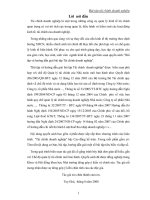Thuyết trình môn tài chính doanh nghiệp CASH FLOWS AND LEVERAGE ADJUSTMENTS
Bạn đang xem bản rút gọn của tài liệu. Xem và tải ngay bản đầy đủ của tài liệu tại đây (2.31 MB, 79 trang )
CASH FLOWS AND
LEVERAGE ADJUSTMENTS
PROFESSOR TRAN NGOC THO
GROUP 3 - PAPER 6 WEEK 11TH
1. Lai Minh Khoi (Group Leader)
2. Pham Le Hanh Nguyen
3. Nguyen Thi Thuy Dung
4. Vu Quynh Hoa
ĐẠI HỌC KINH TẾ TP.HCM - KHOA TÀI CHÍNH
Michael Faulkender, Mark J. Flannery, KristineWatsonHankins, Jason M.Smith
CONTENT
1
• INTRODUCTION
2
• BASIC LEVERAGE MODELS & DATA
3
• INITIAL ESTIMATION RESULTS
4
• THE EFFECT OF CASH FLOW ON
CAPITAL MARKET ADJUSTMENT COST
5
• ROBURSTNESS
6
• FINANCIAL CONSTRAINTS & MARKET TIMING
7
• SUMMARY & CONCLUSION
Do firms have leverage targets?
How quickly do they approach these targets?
What are the drivers of the targets?
What are the impediments to achieving those targets?
impediment (n) : sự trở ngại
1. INTRODUCTION
1/17
1. INTRODUCTION
• Welch (2004) is the obvious exception:
"Unfortunately, the more interesting hypothesis that
firms target an optimal debt ratio (rather than just their
past debt ratio) is not explorable because of lack of
identification of an “optimum”— both theoretically and
empirically. However, added lags in actual debt ratio
terms in the regressions have no significance"
(Capital structure and stock returns. Journal of Political
Economy, 106–131)
2/17
• Firms do have targets, but that the speed with which
these targets are reached is unexpectedly slow. This has
moved the literature toward a search for the source(s)
of adjustment costs.
+ Fisher, Heinkel, and Zechner (1989) argue that firms will
adjust leverage only if the benefits of doing so more than
offset the costs of reducing the firm’s deviation from target
leverage.
+ Altinkilic and Hansen (2000) present estimates of security
issuance costs.
+ Leary and Roberts (2005) derive optimal leverage
adjustments when transaction costs have fixed or variable
components.
1. INTRODUCTION
deviation (n) : sự sai lệch
derive (v): tìm thấy
3/17
• The cost of adjusting leverage depends not only on
explicit transaction costs, but also on the firm’s
incentive to access capital markets for other reasons.
+ Profitable investment opportunities will drive some firms to raise
external funds, and leverage can be adjusted by choosing between the
issuance of debt vs. equity.
+ Other firms (cash cows) routinely generate cash beyond the value of
their profitable investment opportunities and may eventually
distribute that cash to stakeholders. Leverage can change by choosing
to repay debt vs. repurchasing shares or paying dividends
• A firm’s cash flow realization can substantially affect the
cost of making a leverage adjustment, regardless of
whether the firm is raising or distributing external funds.
Firms not otherwise transacting with the market face a
higher adjustment cost.
1. INTRODUCTION
4/17
Two stylized examples illustrate the joint effect of
adjustment costs and cash flows on observed
leverage adjustments.
1. INTRODUCTION
ADJUSTMENT
5/17
1. INTRODUCTION FIRST EX
LEVERAGE TARGET
TARGET
CURRENT
start out
1 year
≈0
If accessing external capital
markets entails transaction costs,
this firm is much more likely to
adjust its leverage in the 2nd year.
Yet its market access costs have not
changed between these two years.
6/17
Two firms are under-levered and wish to move closer to their
leverage targets.
Firm A
• Low costs of accessing external
markets, but rarely does so
• Operating cash flows are
usually sufficient to fund its
valuable investment
opportunities, but little more.
• Adjusting its leverage would
require a "special" trip to the
capital markets, and the
associated costs would be offset
only by the benefits of moving
closer to target leverage
Firm B
• Higher access costs
• Operating cash flows are much
more volatile, investment
opportunities are so great that
funding them requires external
capital
• Has large excess cash flows,
which it finds optimal to
distribute to its stakeholders
1. INTRODUCTION SECOND EX
7/17
While engaging in those capital market
transactions, this firm can simultaneously
adjust its leverage at relatively low marginal
cost. We might therefore observe that the
firm with higher adjustment costs (Firm B)
nonetheless adjusts its capital structure
more frequently than Firm A.
Two firms are under-levered and wish to move closer to
their leverage targets.
1. INTRODUCTION SECOND EX
8/17
1. INTRODUCTION
Both of these examples indicate that a
firm's cash flow situation may
substantially affect its net incentive to
move toward a target leverage ratio, if it
cares about such things. This effect is in
addition to the role the various
components of cash flow may have on
the target leverage ratio itself.
Two stylized examples illustrate the joint effect of
adjustment costs and cash flows on observed leverage
adjustments.
9/17
1. INTRODUCTION
Some previous researchers have
investigated the impact of these
adjustment cost proxies on target
leverage or the choice of securities to
issue (e.g., Hovakimian, Opler, and
Titman, 2001; Korajczyk and Levy,
2003; Leary and Roberts, 2005).
However, we are the first to interact
adjustment speed measures with
cash flows, and thus evaluate the
joint effect of transaction costs and
cash flow needs on firms'
adjustments toward target.
10/17
• Accounting for a firm's cash flow realization provides
significantly different interpretations from what has been
documented in the literature.
We estimate that firms with cash flow realizations near
zero close 23-26% of the gap between actual and target
leverage ratios each year. This adjustment speed
resembles those reported previously in the literature (e.g.,
Lemmon, Roberts, and Zender, 2008; Huang and Ritter,
2009).
Firms with cash flows significantly exceeding their
leverage deviation exhibit adjustment speeds in excess of
50%. This number rises to greater than 70% if the firm is
over-levered.
1. INTRODUCTION
resemble (v) : tương tự
11/17
• The magnitudes of these estimated parameters
indicate that cash flow realizations have a first-order
effect on firms' convergence toward target leverage
ratios.
By showing that adjustments toward target leverage
vary with the marginal cost of implementing leverage
changes, we provide empirical evidence consistent
with the widely used partial adjustment model.
Ignoring cash flows therefore imposes an
inappropriate constraint on adjustment speeds in
typical partial adjustment models of financial
leverage.
1. INTRODUCTION
12/17
• Our results are robust to alternative measures of cash
flow, the incorporation of firms' beginning-of-period
cash position into the cash flow calculation, and alter-
native estimates of the firm target leverage levels.
1. INTRODUCTION
13/17
• Our results also bear on the recent evidence that
randomly generated leverage adjustments can yield
empirical results that resemble leverage-targeting
and partial adjustment behavior (e.g., Chang and
Dasgupta, 2009; they and Welch, 2010). Chang and
Dasgupta (2009, p. 1794) conclude that for
identifying target behavior, "Looking at leverage
ratios is not enough, and even possibly misleading."
These studies impose the same adjustment speed
on all sample firms.
1. INTRODUCTION
14/17
• One of our contributions is to identify ex ante firms
that are likely to make larger leverage adjustments
based on characteristics other than their leverage
preferences (if any).
• The resulting evidence confirms the performance of a
partial adjustment model in a more refined
environment than studies that estimate the same
adjustment speed across all sample firms.
• Moreover, the large estimated adjustment speeds
differ greatly in economic significance from the
adjustment speeds generated by the Chang and
Dasgupta (2009) simulations.
1. INTRODUCTION
15/17
• With our specification in place, we then investigate
the impact of financial constraints and market
timing on adjustment speeds.
Financially constrained firms may find it expensive (or
impossible) to issue securities that would move them
toward their target leverage ratios (Korajczyk and
Levy, 2003).
Similarly, firms' security issuances or redemptions
may reflect market timing or asset mispricing effects
in addition to a potential desire to move toward
target leverage.
1. INTRODUCTION
16/17
• For instance, an over-levered firm that considers its
shares to be overvalued will see an adjustment
toward target leverage via an equity issuance as low
cost.
However, if that same firm were under-levered, it
may choose to become even more under-levered if
the perceived benefit of issuing mispriced equity
exceeds the marginal value of approaching target
leverage.
1. INTRODUCTION
17/17
2. BASIC LEVERAGE MODELS & DATA
DATA:
• All Compustat firms with the exception of financial
firms (Standard Industrial Classification (SIC) 6000-
6999) and utilities (SIC 4900-4999), for the time
period 1965-2006.
• Using the combination of annual Compustat and
Center for Research in Security Prices (CRSP) data.
MODEL:
• We estimate a partial adjustment model that
specifies the target capital ratio as depending on the
firm characteristics employed by Flannery and
Rangan (2006).
1/12
A standard partial adjustment model of firm capital
structure estimates a regression of the form:
2. BASIC LEVERAGE MODELS & DATA
(1)
D
i,t
: the firm's outstanding debt at time t
A
i,t
: the firm's outstanding book assets at time t
L
i,t
: contemporaneous leverage
L
i,t-1
: lagged leverage
L*
i,t
: the estimated target leverage ratio, given firm
characteristics at t -1
λ (%) : "speed of adjustment" toward target.
2/12
We revise (1) to separate a firm's leverage change
into a passive, mechanical component and an active
adjustment:
2. BASIC LEVERAGE MODELS & DATA
(2)
NI
t
: equal to net income during the year ending at time t.
L
p
i,t-1
: Leverage at t if the firm engages in no net capital
market activities.
The left-hand side of (2) therefore equals the firm's active
"adjustment" toward target capital structure change.
3/12
2. BASIC LEVERAGE MODELS & DATA
MEASURE:
• Although previous studies have used both market-
valued and book-valued equity measures, we
concentrate on book leverage because decomposing
the active and passive pieces is more straightforward.
• To reduce the effect of outliers, all ratios are
winsorized at the first and ninety-ninth percentiles.
4/12
2. BASIC LEVERAGE MODELS & DATA
MEASURE:
• Both regressions (1) and (2) rely on an estimated
target leverage, L
*
i,t
.
• The most challenging aspect of estimating either
regression is constructing an estimate of the firm's
target leverage. Many recent papers estimate target
leverage concurrently with the speed of adjustment
toward target, as in (2).
For reasons that will become more clear below in
Section 6.1, we estimate a target first; then (1) or (2)
can be estimated by ordinary least squares (OLS) with
bootstrapped standard errors.
5/12









